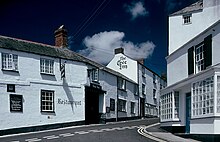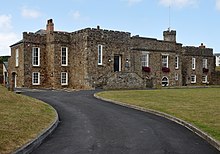Bude (Cornwall)
|
Bude Cornish Porthbud |
||
|---|---|---|
| Coordinates | 50 ° 50 ′ N , 4 ° 33 ′ W | |
| OS National Grid | SS215065 | |
|
|
||
| Residents | 9222 | |
| administration | ||
| Post town | BUDE | |
| ZIP code section | EX23 | |
| prefix | 01288 | |
| Part of the country | England | |
| region | South West England | |
| Ceremonial county | Cornwall | |
| Unitary authority | Cornwall | |
| Civil Parish | Bude-Stratton | |
| British Parliament | North Cornwall | |
| Website: www.visitbude.info | ||
Bude is a village on the north coast of the county of Cornwall near the border with Devon in south-west England . The place is located to the right and left of the Neet River and has recently become a popular holiday destination thanks to the extensive sandy beaches on both sides of the river mouth. The urban sprawl through holiday homes and hotels was limited.
Urban development
In the second half of Queen Victoria's reign , England's middle class discovered the charm of bathing in the sea. In addition, the romantic transfiguration of this epoch promoted enthusiasm for wild landscapes and for the Arthurian legend native to north Cornwall . The London and South Western Railway responded to this trend in 1879 by expanding its network to Holsworthy . From there, the holidaymakers came to Bude by horse-drawn carriage, until this last section could be covered by rail in 1898. In the course of this development, tourism flourished in Bude, but the town was never a serious competitor for Newquay and the holiday areas in South Cornwall or Devon .
Economy and Infrastructure
The location is the landing point for the Apollo transatlantic fiber optic cable and the TAT-14 . A station of the GCHQ is located here .
Attractions
In 1825, a canal that still exists today was built in the village parallel to the river. It was used to transport sand containing seaweed and calcium carbonate to improve the acidic soil in Cornwall, and slate and granite inland for export. A large part of the exhibition in the Bude-Stratton Town Museum revolves around the Bude Canal and the special "tub boats" used at the time.
Behind the museum, near the beach, stands the crenellated Bude Castle . It was built in 1850 by the local inventor and philanthropist Sir Goldsworthy Gurney .
The neighboring town of Stratton forms a municipality together with Bude, but the townscape has its very own character. Houses and cottages are picturesquely grouped around the town center with the historic pub "The Tree Inn". In 1643, during the English Civil War, the royalists victorious in the Battle of Stratton had their headquarters in this building . Their commander, Sir Bevil Grenville , fell a short time later and was buried in Kilkhampton Church.
literature
- Robert Andrews: The Rough Guide to Devon & Cornwall ; Rough Guides, New York, London, Delhi, 3rd edition 2007, ISBN 978-1-84353-807-3 , p. 346.
Web links
- Information about Bude (English)
- Bude Tourist Information (English)
- Photos of Bude (English)




